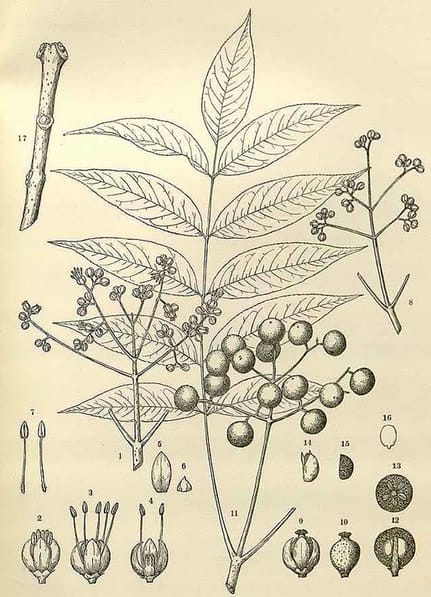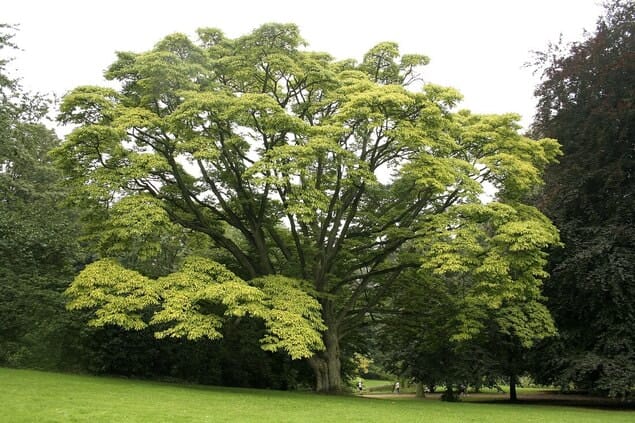Phellodendron, Huang Bai 黄柏
Amur cork-tree barkHuang Bai (TCM)
 Sargent, Trees and shrubs, illustrations of new or little known ligneous plants, 1855
Sargent, Trees and shrubs, illustrations of new or little known ligneous plants, 1855 Phellodendron amurense
Phellodendron amurense(Photo by Jean-Pol GRANDMONT) (Wikimedia)
Botanical name:
Phellodendron chinense, P. amurense
Parts used:
Bark
Temperature & Taste:
Cold, dry. Bitter
Classification:
B. Clears Heat & Damp
Uses:
1. Drains Damp-Heat:
-purges Damp-Heat, especially from the lower abdomen
-Dysuria, difficult or painful Urine
-yellow vaginal discharge, including that with Blood
-Diarrhea, Dysentery, including that with Blood
-Jaundice
-red, swollen, painful swelling of the knees, lower legs and feet
2. Clears Kidney Fire:
-Heat with Yin deficiency: Night Sweats, Hot Flushes, afternoon Fever, low-grade Fever
-‘Steaming Bone Disorder’
-quenches thirst in Diabetes (when caused by Heat)
3. Clears Heat and Toxin:
-Hot sores and lesions of the skin
-Sores and abscesses
-Red, Sore, Inflamed Eyes (can be used topically)
-Eczema
4. Benefits the Kidneys:
-“It treats Impotence” (Zhen Quan), when caused by Heat and combined with Kidney tonics.
-“consolidates the Kidney to strengthen the Bone and Marrow” (Zhang Yuan Su)
-“a very important drug in treating Paralysis” (Zhu Zhen Heng)
-“Long-term use enlightens one’s Intelligence” (Ming Yi Bie Lu)
5. Externally:
-topically to Sores, Abscesses, Eczema, Herpes
-applied to sores on the Penis
-distilled water for Red, Sore eyes
-Tinea Capitis in children (Li Shi Zhen)
-Aphtha

Dose:
Decoction: 3–12 grams
Powder: 1–3 grams
Preparation:
According to traditional sources, if the drug is processed twice, it is better for the upper body (Upper Warmer–Lungs and Heart), if it is process once, it is good for treating the center (Middle Warmer–Stomach and Spleen), and if unprepared, it is better for the lower body (Lower Warmer–Kidneys). (Zhang Yuan Su)
The unprepared root is better to bring down Fire; prepared, it is more gentle on the Stomach. (Li Shi Zhen)
1. Wine-Fried Phellodendron Huang Bai:
The dried root is either sprayed with wine, or else can be briefly soaked in wine. It is then stir-fried on a low heat until dry. It is less cold, and better to enter the Blood and leads the herb to the upper body.
2. Salt-Prepared Phellodendron Huang Bai:
The bark is stir-fried with Salt Water (10% of its weight) until the salt water is absorbed. This works more on the Kidneys and is better to clear Heat from Deficiency. It is preferred for Night Sweats and Consumptive Fevers.
3. Honey-prepared Phellodendron Huang Bai:
The dried root is soaked in Honey water:
“First, peel off the coarse bark and then soak it in fresh honey water for half a day. Take it out and dry it in the sun. Then, apply honey on the drug and stir-fry it with strong and mild fire until the honey is all absorbed. Use three liang of honey to every five liang of drug.” (Lei Xiao, from Ben Cao Gang Mu)
This is more moderate in effect, and slightly tonic. It works predominately on the Stomach and is better for cases with deficiency. This preparation method is rarely used today however.
4. Butter-fried Phellodendron Huang Bai:
The dried bark is stir-fried with butter until it turns yellow.
This was recommended for Aphthous sores of the mouth. The prepared drug is held in the mouth. (Lei Gong Paozhi Lun). This method of preparation is generally not used today.
Substitutes
1. Barberry bark.. (The Chinese Huang Bai was classically obtained from Berberis species, but water later collected from Phellodendron) (see here)
Main Combinations:
-Phellodendron Huang Bai with Anemarrhena Zhi Mu
This combination can nourish Yin, clear Heat, and bring down Fire. It nourishes the Lung to support Kidney water metabolism. They are commonly added to Liu Wei Di Huang Wan (Rehmannia 6) to Nourish Yin, and clear Deficient Heat.
-Phellodendron Huang Bai with Atractylodes Cang Zhu
This combination is used to clear Damp-Heat in the lower body, such as swelling and edema but with signs of Heat. It can also be used for weeping Eczema in the lower body.
1. Burning, painful and difficult urination, Dysuria:
i. Phellodendron Huang Bai with Plantain seed
ii. Phellodendron Huang Bai with Anemarrhena Zhi Mu, Poria Fu Ling, Alisma Ze Xie.
iii. Phellodendron Huang Bai with Anemarrhena Zhi Mu (both wine-prepared, 30 grams each), Cinnamon (3 grams). Powder and form pills.
2. Damp-Heat Dysentery, Phellodendron Huang Bai with Coptis Huang Lian, Pulsatilla Bai Tou Weng
3. Acute Diarrhea with abdominal pain, Phellodendron Huang Bai with Costus
4. Damp-heat swelling of the legs, Phellodendron Huang Bai with Atractylodes Cang Zhu and Achyranthes Niu Xi (as in Three Marvel Pills [San Miao Wan] of TCM)
5. Fever with Yin Deficiency, Night Sweats, add Phellodendron Huang Bai and Anemarrhena Zhi Mu to Liu Wei Di Huang Wan.
6. To clear Heat and Toxin from the Interior and Exterior, Upper and Lower Body (ie. the whole body): Phellodendron Huang Bai with Scutellaria Huang Qin, Coptis Huang Lian, Gardenia Zhi Zi. (Si Wei Jie Du Tang)
7. Leukorrhea from Damp-Heat (yellow, foul-smelling discharge), wine-fried Phellodendron Huang Bai with Ailanthus Chun Pi, Paeonia Bai Shao, vinegar-fried Cyperus rotundus (Cu Chao Xiang Fu) (as in Bai Dai Wan of the Chinese Pharmacopoeia)
8. Paralysis, especially of the lower body:
i. from Qi deficiency, Phellodendron Huang Bai with Ginseng and Astragalus Huang Qi
ii. Phellodendron Huang Bai with with Atractylodes Cang Zhu (for Damp heat in the lower body)
iii. Phellodendron Huang Bai with Eucommia Du Zhong, Mistletoe (Sang Ji Sheng) for Kidney weakness.
9. Eczema:
i. Phellodendron Huang Bai with Sophora Ku Shen
ii. Phellodendron Huang Bai with Paeonia Bai Shao, Paeonia Mu Dan Pi, Rehmannia Sheng Di Huang
10. Sores and abscesses,
i. Phellodendron Huang Bai with Rhubarb (Da Huang) topically
ii. Phellodendron Huang Bai with Pig Bile topically
Major Formulas
Huang Lian Jie Du Tang
Bai Tou Weng Tang
Dang Gui Liu Huang Tang
Dang Gui Long Hui Wan
Zhi Bai Di Huang Wan
Da Bu Yin Wan (Great Tonify Yin Pill)
Shang Zhong Xia Tong Yong Tong Feng Wan
Si Wei Jie Du Tang
Cautions:
1. Not used in Cold and Weakness of the Stomach.
Main Preparations used:
Click the Tabs above for more information on this Medicin
GENERAL / REVIEW:
–Phellodendri Cortex: A Phytochemical, Pharmacological, and Pharmacokinetic Review.
–[Textual research of “Huangbo” in classical prescriptions].
ANTI-BACTERIAL:
–Antibacterial activity of phellodendron bark against Streptococcus mutans.
–Chemical Composition and Antibacterial Activity of the Essential Oil of Phellodendron lavallei.
ANTI-FUNGAL:
–Berberine Antifungal Activity in Fluconazole-Resistant Pathogenic Yeasts
ANTI-VIRAL:
–Inhibitory effects of an aqueous extract from Cortex Phellodendri on the growth and replication of broad-spectrum of viruses in vitro and in vivo.
PAPILLOMAVIRUS:
–Effect of heat-clearing and dampness-eliminating Chinese medicine for high-risk cervical cancer papillomavirus infection: a systematic review and meta-analysis of randomized controlled trials.
ANTI-INFLAMMATORY:
–Isolation and characterization of phellodendronoside A, a new isoquinoline alkaloid glycoside with anti-inflammatory activity from Phellodendron chinense Schneid.
–Identification of anti-inflammatory constituents in Phellodendri Cortex and Coptidis Rhizoma by monitoring the suppression of nitric oxide production.
GASTROPROTECTIVE:
–Gastroprotective Effect of Alkaloids from Cortex Phellodendri on Gastric Ulcers in Rats through Neurohumoral Regulation.
COLITIS:
–Compatibility between cold-natured medicine CP and hot-natured medicine AZ synergistically mitigates colitis mice through attenuating inflammation and restoring gut barrier.
ULCERATIVE COLITIS:
–Berberine alleviates inflammation and suppresses PLA2-COX-2-PGE2-EP2 pathway through targeting gut microbiota in DSS-induced ulcerative colitis.
–Alleviating effect of Nexrutine on mucosal inflammation in mice with ulcerative colitis: Involvement of the RELA suppression.
–Dihydroberberine, an isoquinoline alkaloid, exhibits protective effect against dextran sulfate sodium-induced ulcerative colitis in mice.
DERMATITIS:
–Anti-Inflammatory Effects of the LK5 Herbal Complex on LPS- and IL-4/IL-13-Stimulated HaCaT Cells and a DNCB-Induced Animal Model of Atopic Dermatitis in BALB/c Mice.
–Topical Chinese herbal medicine in treating atopic dermatitis (eczema): A systematic review and meta-analysis with core herbs exploration.
–In vitro tests to evaluate embryotoxicity and irritation of Chinese herbal medicine (Pentaherbs formulation) for atopic dermatitis.
ALZHEIMER’S DISEASE:
–Protective effects of berberine against β-amyloid-induced neurotoxicity in HT22 cells via the Nrf2/HO-1 pathway.
DIABETES:
–A Mechanistic Review on How Berberine Use Combats Diabetes and Related Complications: Molecular, Cellular, and Metabolic Effects.
–Determination of the antidiabetic chemical basis of Phellodendri Chinensis Cortex by integrating hepatic disposition in vivo and hepatic gluconeogenese inhibition in vitro.
DIABETIC FOOT ULCERS:
–Multicenter Clinical Trials Analyzing Efficacy and Safety of Topical Cortex Phellodendri Compound Fluid in Treatment of Diabetic Foot Ulcers.
OSTEOPOROSIS:
–Protective Effects of Phellodendron Species on Bone Health: A Novel Perspective on Their Potentials in Treating Osteoporosis and Osteoarthritis.
ARTHRITIS:
–Inhibitory effect of the extract of Phellodendron amurense ruprecht root on collagen-induced arthritis in mice.
–Protective Effects of Phellodendron Species on Bone Health: A Novel Perspective on Their Potentials in Treating Osteoporosis and Osteoarthritis.
BENIGN PROSTATIC HYPERPLASIA:
–Oral administration of berberine represses macrophage activation-associated benign prostatic hyperplasia: a pivotal involvement of the NF-κB.
–A randomized placebo-controlled study: Phellodendron Bawei tablets combined with standard management can improve storage symptoms, sleep quality, and medication compliance in patients with benign prostatic hyperplasia compared to placebo with standard management.
–Compatibility effects of herb pair Phellodendri chinensis cortex and Anemarrhenae rhizoma on benign prostatic hyperplasia using targeted metabolomics.
CANCER:
–Melanogenesis-Inhibitory and Cytotoxic Activities of Limonoids, Alkaloids, and Phenolic Compounds from Phellodendron amurense Bark.
–Berberine and palmatine inhibit the growth of human rhabdomyosarcoma cells.
BONE:
–Anti-tumor efficacy of phellamurin in osteosarcoma cells: Involvement of the PI3K/AKT/mTOR pathway.
BREAST:
–Oxypalmatine regulates proliferation and apoptosis of breast cancer cells by inhibiting PI3K/AKT signaling and its efficacy against breast cancer organoids.
GASTRIC:
–Suppression of FAK by nexrutine inhibits gastric cancer progression.
PROSTATE:
–Palmatine inhibits growth and invasion in prostate cancer cell: Potential role for rpS6/NFκB/FLIP.
INHIBITS METASTASIS:
–Berberine inhibited metastasis through miR-145/MMP16 axis in vitro.
ANAL FISTULA:
–The Effects of Phellodendron Decoction on Wound Healing of Anal Fistula after Anal Fistulotomy.
ACNE:
–Application of Phellodendron amurense facial mask for slight to moderate acne vulgaris.
PERIODONTAL DISEASE:
–An in vitro study of the effects of Phellodendron bark extract and berberine chloride on periodontal pathogenic bacteria in the oral microbiome.
